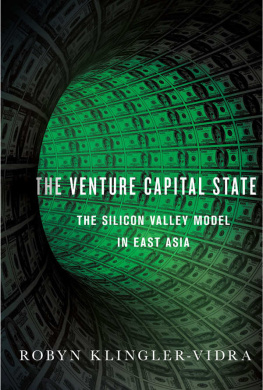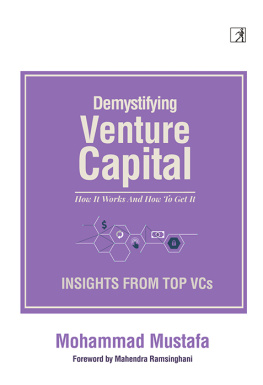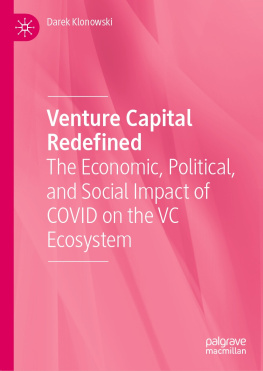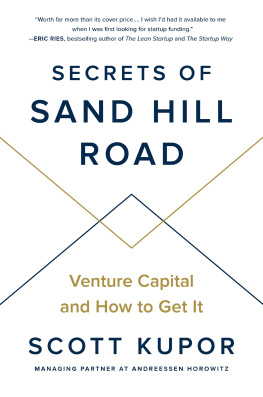The Venture Capital State
The Silicon Valley Model in East Asia
Robyn Klingler-Vidra
Cornell University Press
Ithaca and London
To Eze
Contents
Illustrations
Figures
Tables
Acknowledgments
I owe a debt of gratitude to all the policymakers, venture capitalists, industry association leaders, international organization staff, academics, and entrepreneurs who offered me their time, insights, and data. In each country I benefited from at least one particularly helpful contact who provided further introductions. In Hong Kong, Brandon Sedloff opened his Rolodex; in Taiwan, Emilie Tsai and James Hill were essential to obtaining interviews; and Meng Wong offered his considered analysis and access to policymaking in Singapore. I am also grateful for the financial support that made this books East Asian fieldwork possible. Fieldwork conducted in Hong Kong and Taiwan in 2011 and 2012 was financed by a London School of Economics and Political Science (LSE) international relations department grant. The second major installment of East Asian fieldwork was carried out while based at the National University of Singapore Lee Kuan Yew School of Public Policy in 2012 on a research exchange. Interviews in Israel and Hong Kong between 2013 and 2015 were supported by a Senior Research Fellowship with Coller Institute of Venture at Tel Aviv University. Access to key sources in Israel was made swiftly available by Zvika Halfin.
Academic communities at the LSE and Kings College London offered friendship, tough questions, and valuable recommendations. Feedback on conference presentationsat the New Approaches to Building Markets in Asia conference (October 2011, Singapore), International Studies Association annual conventions (201217), the International Studies Review presidential special issue on diffusion workshop (July 2013, Berlin) and the What Is Patient Capital, and Where Does It Exist? workshop for the Socio-Economic Review special issue on patient capital (February 2016, Berlin)proved immensely helpful. Participation in the Warwick Manuscript Development workshop in October 2014, organized by Len Seabrooke, was especially valuable. T. J. Pempel, my discussant at the workshop, gave feedback and encouragement that had a remarkably positive impact on the book taking shape. Sylvia Maxfield and Magnus Ryner both offered crucial mentorship when my focus waned, and Valbona Muzaka, Iain Hardie, Lawrence Saez, Covadonga Meseguer, and Peter Kingstone were generous in giving feedback on key portions of the book. My research program has been shaped by collaborations with Dan Breznitz, Martin Kenney, Etel Solingen, Ramon Pacheco Pardo, Sylvia Maxfield, Elizabeth Thurbon, Ka Ho Mok, Lena Rethel, Poh Kam Wong, Richard Deeg, Toby James Carroll, Darryl Jarvis, and Philip Schleifer. My project with Robert Wade on policy distraction has helped focus this books argumentation (this is, of course, in addition to the motivational role his seminal work Governing the Market played in undertaking this line of research in the first place). Robert Falkner guided the formulation of the projects aim and continues to serve as my model of the consummate professional and collegial academic.
I thank my nonacademic editing team, consisting of my brother, Robert Klingler, and my husband, Eze Vidra. They kept me focused on answering the all-important so what? question. Eze has motivated me, shared his expertise, and offered unwavering support over the years and across the rounds of edits. For all this, and so much more love, encouragement, and partnership, I dedicate this book to him. I would like to thank our children, Rafael and Maya, for bringing immense joy to my life and forcing me to slow down and see this book in the bigger picture. I thank my parents, Renee and Robert, for the opportunity to pursue this enchanting academic path, and for my loving family in the United States and Israel for their support along the way. Last but certainly not least, I thank the Cornell University Press team: Roger Haydon for his professionalism and humor; Peter Katzenstein for his tremendous ability to deliver constructive criticism that consistently struck at the core of the books issues, both theoretical and empirical; and two external reviewers for their instructive suggestions.
Abbreviations
| ARF | Applied Research Fund (Hong Kong) |
| AVCPEC | Asian Venture Capital and Private Equity Council |
| CEPD | Council for Economic Planning and Development (Taiwan) |
| CIER | Chung-Hua Institution for Economic Research |
| DPP | Democratic Progressive Party (Taiwan) |
| EC | Economic Committee (Singapore) |
| EDB | Economic Development Board (Singapore) |
| ERISA | Employee Retirement Income Security Act (United States) |
| ESVF | Early-Stage Venture Funding (Singapore) |
| ExCo | Executive Council (Hong Kong) |
| GIO | Government Information Office Executive Yuan, Republic of China |
| GIP | Global Investor Program (Singapore) |
| GIS | Government Information Services (Hong Kong) |
| HKVCA | Hong Kong Private Equity and Venture Capital Association |
| ICT | information and communications technology |
| IDB | Industrial Development Bureau (Taiwan) |
| III | Institute for Information Industry (Taiwan) |
| IPO | initial public offering |
| ITB | Innovation and Technology Bureau (Hong Kong) |
| ITC | Innovation and Technology Commission (Hong Kong) |
| ITRI | Industrial Technology Research Institute (Taiwan) |
| KMT | Kuomintang (Taiwan) |
| LegCo | Legislative Council (Hong Kong) |
| LP | limited partnership |
| MITI | Ministry of International Trade and Industry (Japan) |
| MNC | multinational corporation |
| MoEA | Ministry of Economic Affairs (Taiwan) |
| MoF | Ministry of Finance (Hong Kong, Taiwan, Singapore) |
| MTI | Ministry of Trade and Industry (Singapore) |
| NDC | National Development Council (Taiwan) |
| NDF | National Development Fund (Taiwan) |
| NDP | National Development Plan (Taiwan) |
| NRF | National Research Foundation (Singapore) |
| NSTB | National Science and Technology Board (Singapore) |
| NVCA | National Venture Capital Association (United States) |
| NZVIF | New Zealand Venture Investment Fund |
| OCS | Office of the Chief Scientist (Israel) |
| PAP | Peoples Action Party (Singapore) |
| PRC | Peoples Republic of China |
| R&D | research and development |
| ROC | Republic of China |
| SAR | Special Administrative Region |
| SME | small- and medium-sized enterprise |
| SVCA | Singapore Private Equity and Venture Capital Association |
| TIER | Taiwan Institute of Economic Research |
| TIF | Technopreneurship Investment Fund (Singapore) |
| TVCA | Taiwan Private Equity and Venture Capital Association |
| VC | venture capital |
| VoC | varieties of capitalism |
1
The Venture Capital State
The road to the free market was opened and kept open by an enormous increase in continuous, centrally organized and controlled interventionism.
Next page





